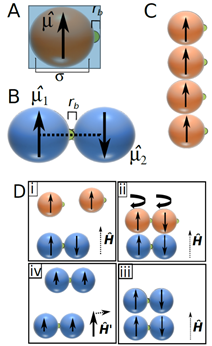Self-Replication with Dipolar Colloids
Scientific Achievement
Developed a self-replication model and validated it in the context of magnetic colloids.

Dipole replication scheme. (A) Detailed sketch of the dipole model used for self-replication. (B) A dimer template which will be replicated. (C) If no colloids are bound, the preferred configuration for low dipole concentrations in a weak field is a line. Binding sites are never close enough to form a new dimer. (D) The four-step replication cycle. In steps i-iii, a template replicates. In step iv, a strong external field is reoriented continuously to dissolve clusters.
Significance and Impact
The development of self-replicating structures, which exhibit exponential growth, has the potential to revolutionize technological and manufacturing paradigms.
Research Details
- Exponential growth of dimers was demonstrated using a simple system of magnetic colloids with a magnetic drive and minimal environmental control.
- Demonstrated the dependence of dimer exponential growth rates on energy cycle.
- By controlling the solvent’s electrostatic interaction with the colloids, exponential growth with a very low (0.3%) error rate was achieved.
Self-replication With Magnetic Dipolar Colloids
Dempster, J.M., Zhang, R., Olvera de la Cruz, M.
Phys. Rev. E 92, 2015, 042305.
Work performed at Northwestern University
